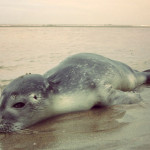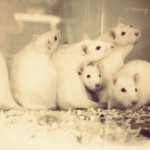‘Seal rescue disrupts research’
This year, the seal rescue at Pieterburen began research in collaboration with Ton Groothuis, professor of behavioural biology at the RUG, in order to learn more about the seal situation in the Dollard area. The research follows on from the pilot that the sanctuary carried out last year in collaboration with the University of Utrecht.
The pilot found that a pup that is alone and crying does not have to be brought directly to the sanctuary. ‘Seal pups have been proven to be less vulnerable than they seem’, says Groothuis. ‘Pups are suckled by multiple female seals, even if they have been sitting on their own for a while. The question is whether bringing in the pups causes unnecessary separation of the mother and her young or not, and the consequences of doing so, such as missing the socialisation period among seals, after it has been released back into the wild are unclear.’
Overly enthusiastic
Groothuis is worried that the new seal rescue in Termunten will be overly enthusiastic about bringing in every pup that is found alone. ‘Taking the seals away from the research area makes our research impossible to do.’
‘It is more peaceful in the Dollard area for the young than elsewhere’
This is why the professor filed a complaint with the state secretary of nature against the seal rescue Eemsdelta Foundation, the official name of the sanctuary in Termunten. The complaint was signed by the RUG board, and the seal rescue is furious.
False allegations
‘We feel that the RUG is making false allegations against us’, says Jeroen Boer, president of the foundation. The complaint made by Groothuis claims that bringing in the seal pups causes them to suffer, but that is twisting the facts, says Boer. He concedes that the situation in the Dollard certainly needs to be investigated, but leaving the animals to their fate is crossing the line. ‘If an animal is in trouble, we can see that.’
Boer draws support from researchers other than Groothuis. ‘We base our protocols on 45 years of experience and a recently graduated PhD researcher’, he states, by which he means Nyke Osinga’s dissertation from the University of Leiden. She researched the pups for seven years, and her results were completely different: seal mothers would never leave their young alone.
As such, the president of the new seal rescue began to worry about the policy of the other sanctuary at Pieterburen. According to Boer, his ‘competitor’ feels that research is more important than the wellbeing of the animals.
From 30 to 3
Pieterburen does not agree with the criticism. The seal rescue did in fact adapt its policy in connection with the pilot study in 2015. The rescue formerly took in around 30 pups per year, but last year, the number of pups brought in was three. But there were justified reasons for doing so, says biologist Sander van Dijk of the seal sanctuary.
‘In the Dollard area, the sandbanks remain dry even when the water is high, and they are also close to the road’, he says. Young seals can safely rest on the sandbanks while the mother catches fish, whereas they are forced to swim in other areas. ‘This is why so many seals come to the Dollard during the birthing season, which is two weeks long. In the Dollard, it is more peaceful for the young than elsewhere.’
Boer feels that it would be premature to adjust the policy after a one year pilot study. ‘Our situation in the Dollard is unique with a lot of disruption, and we want to put the animal first.’
Seals in Groningen
• In the Netherlands, there are around 8,000 common seals and 3,500 grey seals. The grey seal has only been back in the country since 1983, partly due to the changing coastline and good protection.
• The birthing season for common seals is from May until June, while the grey seal gives birth between December and January. The Dollard is an exclusive birthing place for common seals: grey seals are not found there. In the last few years, the population at the Dollard has grown to around 300 animals.
• Osinga published an article in which she states that mother seals would never leave their young alone, but due to disruptions, they often lose each other. She also found that young pups are rarely fed by other mothers.
• These findings stand in contrast to observations made by Pieterburen in 2015.
• Pieterburen admits that it only brought in three pups from the Dollard last year as a result of the research, in comparison to 37 pups in 2012. According to the founders of the new rescue at Eemsdelta, the research is just a front so that fewer animals have to be brought in and money can be saved.
• The municipality of Delfzijl says that it approves of the new rescue for now, but is searching for a new location together with the foundation. Due to legislative changes, the province of Groningen will decide in 2017 whether having two sanctuaries is necessary. The permit which has now been granted by the state secretary is temporary.
• Osinga also admits in her dissertation that more research on the success rate of the pups brought into in the sanctuary is necessary.






